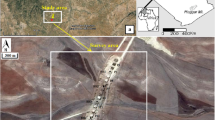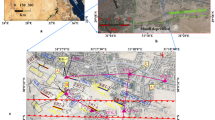Abstract
Two-dimensional electric resistivity tomography and ground-penetrating radar (GPR) study was carried out in the eastern Rufa Graben, Riyadh area. Dipole–dipole configuration was used with a total length of 360 m and an electrode spacing of 5 m. In addition, the same number of ground-penetrating radar profiles was conducted in the same location of the electrical resistivity tomography (ERT) profiles. The goal of this study was to map and delineate the subsurface karstic features in the study area such as sinkholes, cavities, and fractured zones. The two methods showed the efficiency to detect the near-surface cavities and their distribution in the study area. The detected cavities were of different sizes. The air-filled cavities have appeared in ERT sections as anomalies that have high resistivity values while the cavities filled with wet clay were characterized with low-resistivity values. In GPR sections, the karstic features were seen by either hyperbola diffractions or uplift and discontinuity in horizontal reflection events. The results obtained from this study will contribute in solving the geotechnical problems for any expected future constructions planned to be done in the study area.



















Similar content being viewed by others
References
Abdallatif T, Khafagy A-SA, Khozym A (2015) Geophysical investigation to delineate hazardous cavities in Al-Hassa Karstic Region, Kingdom of Saudi Arabia, in Engineering Geology for Society and Territory Volume 5 Springer. p. 507–514
Abdeltawab S (2013) Karst limestone foundation geotechnical problems, detection and treatment: case studies from Egypt and Saudi Arabia. Int J Sci Eng Res 4(5):376–387
Abu-Shariah MI (2009) Determination of cave geometry by using a geoelectrical resistivity inverse model. Eng Geol 105(3–4):239–244
Amrouche M, Saibi H (2019) Feasibility study of karst feature detection using microgravity data inversion. International Conference on Engineering Geophysics, United Arab Emirates University, Al-Ain, UAE
Carbonel D, Rodríguez-Tribaldos V, Gutiérrez F, Galve JP, Guerrero J, Zarroca M, Roqué C, Linares R, McCalpin JP, Acosta E (2015) Investigating a damaging buried sinkhole cluster in an urban area (Zaragoza city, NE Spain) integrating multiple techniques: geomorphological surveys, DInSAR, DEMs, GPR, ERT, and trenching. Geomorphology 229:3–16
Cardarelli E, Cercato M, Cerreto A, Di Filippo G (2010) Electrical resistivity and seismic refraction tomography to detect buried cavities. Geophys Prospect 58(4):685–695
Chalikakis K, Plagnes V, Guerin R, Valois R, Bosch FP (2011) Contribution of geophysical methods to karst-system exploration: an overview. Hydrogeol J 19(6):1169
Claerbout JF, Muir F (1973) Robust modeling with erratic data. Geophysics 38(5):826–844
Cook JC (1965) Seismic mapping of underground cavities using reflection amplitudes. Geophysics 30(4):527–538
Daniels DJ (2004) Ground penetrating radar, vol. 1. IEE radar, sonar, navigation, and avionics series
Davis J, Annan A (1989) Ground-penetrating radar for high resolution mapping of soil and rock stratigraphy. Geophys Prospect 37(5):531–551
Deceuster J, Delgranche J, Kaufmann O (2006) 2D cross-borehole resistivity tomographies below foundations as a tool to design proper remedial actions in covered karst. J Appl Geophys 60(1):68–86
Grandjean G, Gourry J-C (1996) GPR data processing for 3D fracture mapping in a marble quarry (Thassos, Greece). J Appl Geophys 36(1):19–30
Grasmueck M (1996) 3-D ground-penetrating radar applied to fracture imaging in gneiss. Geophysics 61(4):1050–1064
Hollingsworth E, Brahana V, Inlander E, Slay M (2008) Karst Regions of the World (KROW): global karst datasets and maps to advance the protection of karst species and habitats worldwide. In: USGS Karst Interest Group Proc., Kentucky, May 27-29, 2008. Ed. E. L. Kuniansky, USGS Scientific Investigations Rep. 2008-5023, p. 17–24
Jado A, Johnson D (1983) Solution caverns in the Dammam Dome, Dhahran, Saudia Arabia. Springer Heidelberg tiergartenstrasse 17, D-69121 Heidelberg, Germany. p. 69–73
Loke MH (2000) Electrical imaging surveys for environmental and engineering studies: a practical guide to 2-D and 3-D surveys. Electronic version available from http://www.terraplus.com
Loke MH (2002) Rapid 2-D Resistivity and IP inversion using the least-squares method, Geoelectrical Imaging 2D and 3D. Geotomo Software.
McGrath R, Styles P, Thomas E, Neale S (2002) Integrated high-resolution geophysical investigations as potential tools for water resource investigations in karst terrain. Environ Geol 42(5):552–557
Metwaly M, AlFouzan F (2013) Application of 2-D geoelectrical resistivity tomography for subsurface cavity detection in the eastern part of Saudi Arabia. Geosci Front 4(4):469–476
Parise M, Gunn J (2007) Natural and anthropogenic hazards in karst areas: recognition, analysis and mitigation. Geological Society of London
Phoenix HC (1985) Interpretation of radiometric data from the cover rocks geophysical survey, in Phoenix Corporation report prepared for U.S. Geological Survey and Saudi Arabian Deputy Ministry for Mineral Resources, Jeddah p. 76p
Powers RW, Ramirez LF, Redmond CD, Elberg EL (1966) Geology of the Arabian Peninsula. Geological survey professional paper. 560:1–47
Pueyo-Anchuela Ó, Casas-Sainz AM, Soriano MA, Pocoví-Juan A (2010) A geophysical survey routine for the detection of doline areas in the surroundings of Zaragoza (NE Spain). Eng Geol 114(3–4):382–396
Reynolds JM (2011) An introduction to applied and environmental geophysics. John Wiley & Sons
Saibi H., M. Amrouche (2018) Microgravity inversion for 3D subsurface density modeling of Al-Ain Region, Abu Dhabi, United Arab Emirates. JpGU Annual Meeting 2018, Chiba, Japan
Saibi H, Amrouche M, Fowler A (2019) Deep cavity systems detection in Al-Ain City from gravity surveys inversion. J Asian Earth Sci 182:103937. https://doi.org/10.1016/j.jseaes.2019.103937
Sandmeier KJ (1998) ReflexW program for the processing of seismic, acoustic or electromagnetic reflection, refraction and transmission data. Sandmeier Software, Karlsruhe
Sum CW, Othman J, Loganathan P (1996) Geotechnical problems in limestone terrain with emphasis on cavities and sinkholes. In Seminar Geologi dan Sekitarn, UKM, Puri Pujangga, Bangi (pp. 102–117)
Takahashi K, Preetz H, Igel J, and Kuroda S (2012) Basics and application of ground-penetrating radar as a tool for monitoring irrigation process. INTECH Open Access
Ulriksen CP (1982) Application of impulse radar to civil engineering. Lund University. Doctoral Thesis
Vaslet D, Al-Muallem M, Maddeh S, Brosse J, Fourniquet J, Breton J, Le Nindre Y (1991) Explanatory notes to the geologic map of the Ar Riyad Quadrangle, sheet 24 I, Kingdom of Saudi Arabia. Saudi Arabian Deputy Ministry for Mineral Resources, Jeddah. Geosciences 121:1–54
Wilson WL, Beck BF (1988) Evaluating sinkhole hazards in mantled karst terrane. In Geotechnical aspects of karst terrain exploration, foundation design and performance, and remedial measures. ASCE
Yassin RR, Muhammad RF, Taib SH, Al-Kouri O (2014) Application of ERT and aerial photographs techniques to identify the consequences of sinkholes hazards in constructing housing complexes sites over karstic carbonate bedrock in Perak, Peninsular Malaysia. J Geogr Geol 6(3):55
Youssef AM, El-Kaliouby HM, Zabramawi YA (2012) Integration of remote sensing and electrical resistivity methods in sinkhole investigation in Saudi Arabia. J Appl Geophys 1(87):28–39
Zhou W, Beck BF, Adams AL (2002) Effective electrode array in mapping karst hazards in electrical resistivity tomography. Environ Geol 42(8):922–928
Funding
This project was supported by the NSTIP strategic technologies program (number 12-WAT-2867-2) in the Kingdom of Saudi Arabia.
Author information
Authors and Affiliations
Corresponding author
Additional information
Responsible Editor: Li Zhen Cheng
Rights and permissions
About this article
Cite this article
Mogren, S. Integrated use of electrical resistivity tomography and ground penetration radar for identifying subsurface sinkholes in Rufa Graben, Central Riyadh. Arab J Geosci 13, 19 (2020). https://doi.org/10.1007/s12517-019-5017-5
Received:
Accepted:
Published:
DOI: https://doi.org/10.1007/s12517-019-5017-5




